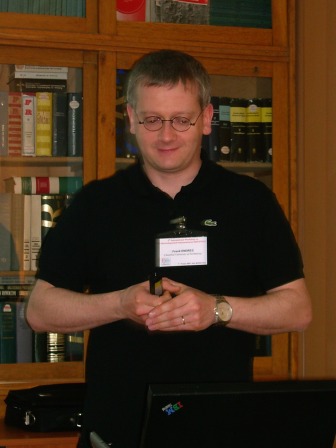|
|
Influence of Ionic Liquids on the grain size of electrochemically made materials
Frank Endres
Clausthal University of Technology,
D-38678 Clausthal-Zellerfeld, Germany
E-mail: frank.endres@tu-clausthal.de
|

|
Due to wide electrochemical and wide thermal windows ionic liquids are quite interesting solvents for the chemical
and electrochemical synthesis of materials. It is well known in the ionic liquids community that aluminium can
easily be electrodeposited in ionic liquids of the first generation, i.e. from liquids based on AlCl3. In these
liquids aluminium is usually obtained as a microcrystalline material. There are more than 100 papers available in
literature on metal and alloy deposition in first generation ionic liquids, but there are some limitations: on the
one hand liquids based on AlCl3 are extremely hygroscopic which requires handling under inertgas conditions, on the
other hand it easily happens that aluminium is codeposited with the desired element, in part in the underpotential
deposition regime. Therfore we started around 2001 with experiments on the suitability of air and water stable
ionic liquids for metal and semiconductor electrodeposition. In the first experiments we could show that germanium
can be electrodeposited from 1-Butyl-3-methylimidazolium hexafluorophosphate ([BMIm]PF6), a somewhat difficult to
handle ionic liquid which in the presence of water is subject to some decomposition. Nevertheless we could show by
in situ scanning tunneling microscopy and by in situ tunneling spectroscopy that the electrochemically made
germanium is semiconducting. Around 2003 we started with experiments on the electrodeposition of silicon, tantalum,
indium, copper, silver and selenium in 1-Butyl-1-methylpyrrolidinium bis(trifluoromethylsulfonyl)amide ([Py1,4]TFSA),
and we found that in all cases we got - surprisingly - nanoscale deposits with grain sizes between 10 and 200 nm.
This surprising observation motivated us to study the influence of the cation of an ionic liquid on structure and
grain size of chemically and electrochemically made materials in more detail. The electrodeposition of aluminium in
1-Ethyl-3-methylimidazolium bis(trifluoromethylsulfonyl)amide ([EMIm]TFSA) seems to lead under all tested
parameters between 20 and 125 oC to microcrystalline Al with grain sizes between 0.5 and 10 Ám. Under quite similar
conditions we obtain in [Py1,4]TFSA nanocrystalline deposits with sizes between 10 and 200 nm [1]. Thus there is
strong evidence that the cation of an ionic liquid has a strong impact on the deposit grain size. In situ STM
measurements show that there is clearly Al underpotential deposition (upd) on Au(111) in [EMIm]TFSA whereas there
is no clearly visible upd in [Py1,4]TFSA. The electrodeposition of other elements also seems to be
influenced by the cation of an ionic liquid. The plasma-electrochemical deposition of silver in [Py1,4]
trifluoromethylsulfonate also leads to a nanoscale deposit with sizes between 20 and 60 nm [2].
In this lecture an insight into the prospects of ionic liquids for electrodeposition as well as a first insight
into the influence of ionic liquids on grain size and structure of electrochemically made (nano-)materials shall be
given. An introduction in the physical chemistry of ionic liquids can be found in [3].
References
[1] S. Zein El Abedin, E.M. Moustafa, R. Hempelmann, H. Natter, F. Endres, Chem. Phys. Chem. 7 (2006) 1535.
[2] S.A. Mei▀, M. Rohnke, L. Kienle, S. Zein El Abedin, F. Endres, J. Janek, Chem. Phys. Chem. 8 (2007) 50.
[3] F. Endres, S. Zein El Abedin, Phys. Chem. Chem. Phys. 8 (2006) 2101.
|
|